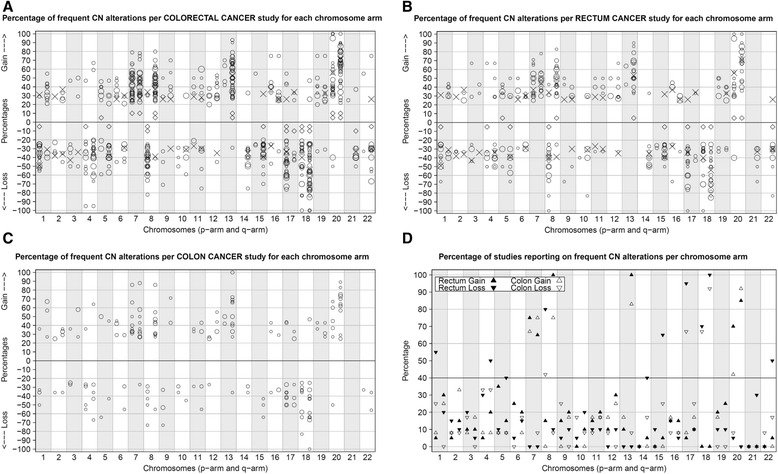Figure 1.

Frequent copy number alterations reported in colorectal cancer studies. Frequent CN alterations were defined as copy number (CN) changes found in at least 25% of the cases in a study cohort. Since most studies did not report low frequency CN alterations, only high frequency CN alterations were summarized. A-C. Percentage of high frequency CN alterations for each chromosome arm reported by different CGH/SNP studies for colorectal (A; plotted from 20% to 100%), rectum (B; plotted from 25% to 100%) or colon (C; plotted from 25% to 100%) cancer. Top panel: Percentages of gains. Lower panel; percentages of losses. Symbol size (circles/diamonds/X’s) indicates the number of rectal cases included in a particular study. X indicates the CN percentage from the current (SNP) study. Indicated losses are restricted to segments containing at least 15 SNPs. Open circles (O) represent other studies with reported percentages or percentages that could be estimated from plots or figures. For two studies [31,53], indicated by black diamonds (◊), percentages were not available. D. The percentage of studies, including the results of this study, were counted and plotted that reported on a chromosome arm showing CN alterations in ≥25% of the cases of that particular study. The percentages per chromosome arm for rectal studies are indicated with black-filled triangles (▲▼), while colon studies are indicated by open triangles (∆∇). Triangles that point upwards (▲∆) indicate the number of studies with reported gains and triangles that point downwards (▼∇) indicate the number of studies reporting on losses found on the various chromosome arms. We considered a particular CN alteration to be common, with high frequency, when at least 40% of the studies reported the CN alteration in at least 25% of the study’s cases.
